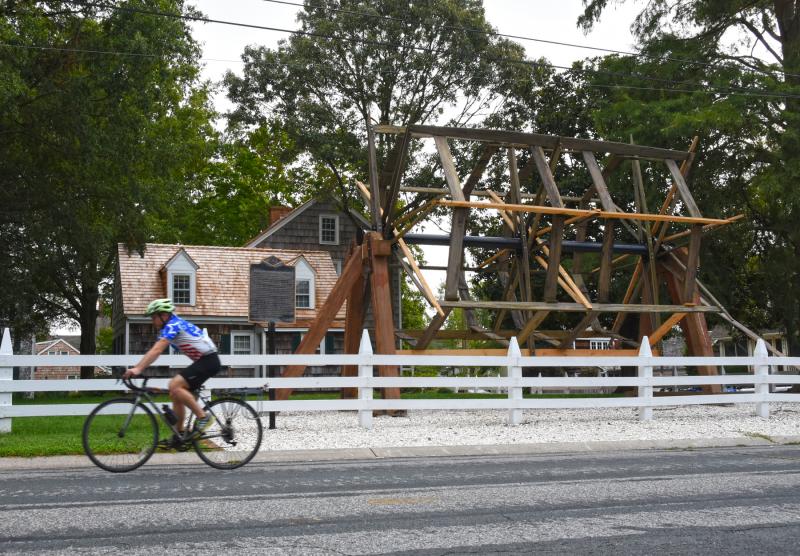The Lewes Historical Society believes the best place to tell the history of its menhaden fishing reel artifact is where it currently sits at the corner of Third and Shipcarpenter streets.
That’s contrary to a decision made by the city’s historic preservation architectural review commission in September. In a unanimous vote, the commission said the reel did not fit in with the rhythm and scale of the surrounding streetscape, and that it should be removed. The city has asked that it be removed by the end of January 2021.
The reel previously sat along the Lewes-Rehoboth Canal next to the Lightship Overfalls. Without permission from the city, historical society officials moved the artifact to its campus, where it was repaired. The dimensions of the cylindrical wooden reel, which was used to pull cotton fishing nets out of saltwater to dry, are 19 feet in height, 32 feet in length and 18 feet in depth.
Now, attorney Mark Dunkle is arguing the historical society never needed permission from HPARC in the first place.
“I think this is a case of being in the right church, but the wrong pew,” Dunkle said during a Nov. 19 meeting with the Lewes African American Heritage Commission.
Dunkle says city code specifically gives HPARC jurisdiction over all residentially and commercially zoned property within the historic district. He argues code does not have jurisdiction over the cultural/historic zone in which the historical society’s campus is located.
“The reel was turned down because it didn’t meet a certain architectural test,” Dunkle said. “But this is not architecture – it’s not a house and it’s not a building.”
Dunkle said it is more appropriate for the African American heritage commission to review because its mission is to preserve historic contributions and educate the public.
Historical society Executive Director Jim Abbott says the menhaden reel is key in telling the history of African Americans in 20th century Lewes.
“We can share the history of the African American community in a stronger voice in the 17th, 18th and 19th centuries, but when it comes to the 20th century, artifacts are rare,” he said. “In the post-World War II redefinition of Lewes from an industrial to a historic community, so many buildings and so many aspects of the African American community have been lost. This gives even greater importance to this reel.”
Abbott said the reel would be included in a walking tour that educates the public about the contributions African Americans have made to the Lewes community.
At the Nov. 19 meeting, Dunkle and Abbott sought an on-the-record vote from the African American heritage commission to endorse the menhaden reel’s significance and continued prominent placement on the society’s campus.
City Manager Ann Marie Townshend advised commissioners against taking a vote because the city did not have legal representation at the meeting.
“The city’s legal counsel has advised … that HPARC does have jurisdiction in this matter,” she said. “That’s why I think it’s important to defer action.”
Councilman Rob Morgan, who serves as an ex officio member of the commission, supported Townshend’s comments.
“She is not asking the commission to not address this issue,” he said. “She is asking that you hear both sides, so the commission does not find itself in the middle of a fight between Lewes Historical Society and HPARC.”
If HPARC indeed has authority over the historical society’s property, the society may resubmit a request for review of the menhaden reel. Although the process is murky, the society at some point may appeal the decision to the board of adjustment.
On Nov. 30, the society sent a letter to members and supporters asking that they write to Lewes Mayor and City Council as well as local, state and federal elected officials for their help to ensure the reel stays put.






















































